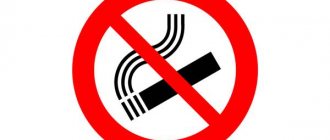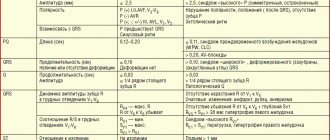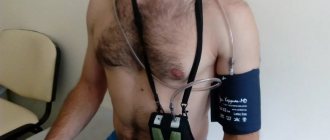24-hour blood pressure (BP) monitoring is a modern research method. Such diagnostics takes into account the daily rhythm of a person’s blood pressure in his or her usual environment. The data obtained together provide a complete picture of the influence of behavioral factors on blood pressure and reflect the dynamics of the influence of antihypertensive drugs in patients receiving therapy for high blood pressure.
How does the device work?
The essence of the procedure is to measure blood pressure at certain intervals. The measurement takes place regardless of the patient’s activities and his wishes - only the doctor sets the time interval. On average, it ranges from 12 to 30 minutes during the day and every hour at night.
During the entire study, the patient fills out a personal diary throughout the day, in which he enters any changes in his state of health and any symptoms that have arisen. By comparing ABPM indicators (24-hour blood pressure monitoring) and diary entries, the attending physician makes an accurate diagnosis. The diary describes the state of activity, rest, and medications the patient is taking. All this data allows us to evaluate pressure drops in a person who is resting or playing sports.
Content:
- How does the device work?
- When is diagnosis prescribed?
- Contraindications to the procedure
- Preparation for the procedure
- Preparation of documents
- Carrying out the procedure
- Preliminary instructions
- Rules for the patient
- What can you learn using ABPM?
- Decoding the results
Blood pressure and activity are two dependent indicators. The basis of the method is the comparison of data that takes into account the patient’s usual activity. In laboratory conditions, the obtained blood pressure readings are unreliable. The procedure lasts for 24-48 hours, depending on the reasons why ABPM was prescribed. A device is fixed on the human body that automatically measures blood pressure.
24-hour blood pressure monitoring at MediCity
ABPM is a paid medical service everywhere.
In our clinic, this diagnostic procedure is affordable. You can sign up for it and other studies (bicycle ergometry, ECG, ECHO-KG, HOLTER) at any time convenient for you. To do this, just call our contact center by phone: +7 (495) 604-12-12.
Cardiologists and other highly qualified medical specialists at MedicCity will do everything to preserve and strengthen your health!
When is diagnosis prescribed?
The most common reason for 24-hour blood pressure monitoring is to assess the effectiveness of antihypertensive therapy, especially in the case of combination treatment using several groups of antihypertensive drugs. Other reasons for prescribing ABPM include the diagnosis of early arterial hypertension, symptomatic arterial hypertension, patients with heart failure, with myocardial hypertrophy, in the presence of brain diseases, and suspected sleep apnea syndrome.
ABPM is used to examine patients suffering from various types of hypotension: constitutional and orthostatic.
ABPM allows you to determine the presence of so-called “office hypertension”, in the diagnosis of which it is necessary to promptly establish a work and rest schedule.
Contraindications to the procedure
The procedure for 24-hour blood pressure monitoring is a completely safe test and has no absolute contraindications. But there are relative contraindications, which include thrombophlebitis of the upper extremities, acute infectious disease (as a temporary contraindication), impaired motor activity due to the severity of some chronic diseases.
Psychological reasons (phobias and fears) are a contraindication for ABPM.
Carrying out the procedure
The patient should sit for a few minutes before the procedure. The key to correct diagnosis is the coordination of the actions of the doctor and the patient. The study is carried out:
- with installation of a cuff and tonometer;
- with the obligatory filling out of the diary by the patient;
- with removal of the device;
- with a comparison of the results obtained and the data entered by the patient.
Installing the device takes no more than 15 minutes. The appropriate position for installing the cuff is sitting. The cuff is placed on the right hand of a right-handed person and on the left hand of a left-handed person. It is important to consider which arm the patient has more active. The mark on the cuff should coincide with the most pulsating point on the arm (blood pressure will be measured using it). The point is located on the distal part of the shoulder and is easy to find. Using a special device, the cuff is fixed on the shoulder. A register and a mercury tonometer extend from this device.
Preliminary instructions
Blood pressure monitoring will proceed without complications if within two days the patient can meet several mandatory conditions: while measuring blood pressure, the patient must take a comfortable position and, if possible, extend his arm with the cuff. If these recommendations are not followed, you will not be able to obtain accurate results.
Excessive physical activity is not recommended on the day of ABPM. If recording of indicators occurs during work or movement, the patient must stop - this rule guarantees accurate results. If possible, during the period of blood pressure monitoring it is necessary to exclude stressful situations. You should not follow the measurements - such behavior will cause nervousness, which will affect the diagnostic results.
There is no need to worry about the operation of the device at night. As far as possible, the patient does his usual activities - goes to work, does household chores. You cannot limit yourself, otherwise you will not be able to get results in an environment close to the natural environment. If unpleasant symptoms occur, the patient makes notes in a diary indicating the time of day and the load that gave the body a negative reaction.
Features of Holter blood pressure monitoring
The technique assumes that the patient will strictly follow the rules and recommendations of the specialist. Otherwise, the readings will be incorrect, which will negatively affect the diagnosis and selection of drug treatment.
ABPM is a simple procedure. A “cuff” is placed on the patient’s arm with a device in the form of a small box attached to it using wires, to which the results of each measurement will be automatically transferred and recorded in memory.
During the entire period of wearing the cuff, a person is required to keep an observation diary in which he must record all the actions he performs during the monitoring period. It is necessary to write down with the exact time:
- time of falling asleep - waking up;
- any physical activity;
- taking medications;
- development of a stressful situation;
- meal.
The diary must indicate any changes in well-being, for example, the appearance of painful sensations.
The total duration of the study is 24 – 28 hours. The first two hours after installation of the cuff are excluded when constructing the graph as adaptation. Our specialist comes to the patient at the appointed time to remove the device. The specialist then extracts the received data to perform processing. The result is given to the patient. The interpretation is carried out by the attending cardiologist.
Rules for the patient
Correct measurements depend entirely on the patient's behavior. Keeping a diary is a prerequisite that guarantees diagnostic results. The daily routine is entered into the diary: sleep, exercise, psycho-emotional experiences, walks, clinical symptoms that arise during the day, taking medications. Detailed records will allow you to assess the condition of the body and the factors that worsen the patient’s well-being.
If any negative symptoms appear, the patient consults a doctor. Headaches (severe migraines), weakness or nausea are reasons to suspend ABPM. It is recommended to avoid crowded places and places with a lot of noise for two days - it will affect the recorder and prevent you from taking correct measurements. If the edge of the cuff moves, it needs to be corrected - the correct position of the cuff is 2 cm below the elbow. If the patient is concerned about the correct conduct of ABPM, the attending physician will be able to make an accurate diagnosis and prescribe effective treatment.
Indications for ABPM
First of all, we recommend that people who have health complaints related to blood pressure undergo daily blood pressure monitoring. If you believe that your blood pressure is “jumping,” then it is extremely important to obtain factual confirmation of this and begin therapy in a timely manner. However, the connection between illness and blood pressure may not be obvious, so you should think about ABPM if:
- regardless of age, complaints arose regarding the cardiovascular system, problems such as: headache, dizziness, weakness, shortness of breath, pain in the heart, arrhythmia, tachycardia, bradycardia, swelling of the legs, etc.;
- episodes of loss of consciousness occur;
- nosebleeds occur frequently;
- Blood pressure rises above 140/90 mmHg. in the presence of a doctor (so-called “white coat” hypertension).
- you are at risk of cardiovascular diseases (this includes people with excess body weight with a family history, strokes and heart attacks, women in menopause, people over 55 years old, smokers).
It is strongly recommended that people who are already undergoing treatment for:
- cardiac diseases (coronary heart disease, atrial fibrillation, as well as after heart surgery and pacemaker implantation, etc.), stroke or heart attack;
- diseases of the kidneys, thyroid gland, nervous system;
- obesity and diabetes;
- hypertension, during a course of antihypertensive drugs to monitor the effectiveness of therapy.
Daily monitoring of blood pressure can not only identify and effectively combat diseases, but also help to significantly improve the quality of life and increase performance. ABPM data will allow the specialist to select the optimal motor mode, taking into account all the characteristics of the body and human activity, and adjust the load and nutrition. Therefore, we recommend taking ABPM:
- For athletes, both professional and amateur, this will improve the effectiveness of their training.
- For future schoolchildren, students in general education and higher education institutions, monitoring will show the optimal time for classes and help find the best ways to improve their performance.
- For pregnant women, if signs of hypertension are observed, it will allow you to exclude or make a diagnosis in a timely manner and promptly begin the required therapy.
The examination procedure is painless, comfortable and has only one contraindication - hand injuries, in which it is simply impossible to install a portable tonometer.
What can you learn using ABPM?
To diagnose the disease, the variability of blood pressure values during the day is used. The analysis of the results obtained is carried out on the basis of 4 indicators. Average blood pressure readings differ at night and during the day. During the daytime, normal blood pressure is 130 to 85 mm, and at night – 120 to 70 mm.
The second indicator is the recorded moments of maximum increase in blood pressure - the number of deviations from the norm indicates the complexity of the disease. The daily index is calculated, consisting of systolic and diastolic blood pressure. The last indicator that allows you to assess the patient’s health status is the magnitude of the morning increase in blood pressure.
The article presents the most important practical aspects of the use of 24-hour blood pressure monitoring, assessment and interpretation of the method data, its clinical and prognostic significance. Indications for 24-hour BP monitoring are systematized, and the relationship between the results of clinical BP measurements and 24-hour BP monitoring is shown.
Practical aspects of the method of daily monitoring of blood pressure
The article presents the most important practical aspects of daily blood pressure monitoring, evaluation and interpretation of the method, its clinical and prognostic significance. Systematized statements to daily monitoring of blood pressure, shows the relationship between the clinical measurement of blood pressure and daily blood pressure monitoring.
Arterial hypertension (AH) is the most important risk factor for the development of cardiovascular complications and mortality. According to a survey conducted within the framework of the targeted federal program “Prevention and Treatment of Hypertension in the Russian Federation,” the frequency of hypertension among the population of the Russian Federation is 39.5% [1]. Early diagnosis of the initial stages of hypertension allows timely lifestyle changes, giving up bad habits and, if necessary, prescribing drug antihypertensive therapy, which leads to a reduction in deadly complications, extends working age and increases life expectancy.
Today, the main method for diagnosing high blood pressure and assessing the effectiveness of treatment remains one or more measurements of blood pressure (BP) during the day. However, such measurements do not provide complete information about the 24-hour blood pressure profile. Not only traditional one-time blood pressure measurements are of diagnostic value, but also blood pressure values during sleep, physical and mental stress, at different times after taking medications, etc. [2]. This information is provided by the method of 24-hour blood pressure monitoring (ABPM). Daily blood pressure monitoring is used to diagnose hypertension or hypotension, select drug therapy, and assess the effectiveness and safety of treatment. ABPM allows you to exclude isolated clinical hypertension and isolated ambulatory hypertension. In addition, ABPM provides important information about the state of the mechanisms of cardiovascular regulation, allows you to determine the daily rhythm of blood pressure, nocturnal hypotension and hypertension, the dynamics of blood pressure over time and the uniformity of the antihypertensive effect of drugs.
Indications for ABPM can be divided into three groups (Table 1).
Table 1.
Indications for ABPM
| Diagnostic | 1. Diagnosis of isolated clinical hypertension (“white coat hypertension”).2. Diagnosis of isolated outpatient hypertension, identification of “workday hypertension” in patients with high levels of stress in the workplace. 3. Diagnosis of borderline hypertension. 4. Detection of nocturnal hypertension. 5. Diagnosis of symptomatic arterial hypotension caused by the use of antihypertensive drugs, autonomic disorders, myocardial infarction, heart failure, adrenal insufficiency, poor tolerance of constant cardiac pacing. 6. Increased lability of blood pressure during repeated measurements, visits, or according to self-monitoring of blood pressure (SBP). 7. To assess changes in blood pressure during nocturnal angina and respiratory failure in patients with sleep apnea syndrome. 8. High values of clinical blood pressure in patients with a small number of risk factors and the absence of changes in target organs characteristic of hypertension. 9. Normal values of clinical blood pressure in patients with a large number of risk factors and/or the presence of changes in target organs characteristic of hypertension. 10. Hypertension in pregnant women and suspected preeclampsia. |
| Therapy control | 1. Selection of patients for drug treatment.2. Assessing the effectiveness and safety of therapy. 3. Assessment of resistance to drug treatment and selection of the optimal treatment regimen in such patients. 4. Study of the individual daily rhythm of blood pressure during treatment. 5. Assessing the effectiveness of correction of hypertension during pregnancy. |
| Prognostic | 1. Before surgical treatment.2. Before childbirth. 3. To assess the risk of developing cardiovascular complications. |
Contraindications to ABPM are complications during previous blood pressure monitoring, skin diseases on the shoulder, thrombocytopenia, thrombocytopathy and other blood diseases during an exacerbation, trauma to the upper extremities, diseases with damage to the vessels of the upper extremities, and patient refusal. Relative contraindications include poor tolerability of the study, severe rhythm and conduction disturbances, systolic blood pressure over 200 mm Hg. Art.
The ABPM method allows you to calculate average daily blood pressure and pulse values, average blood pressure values during the day and night, determine the degree of nocturnal decrease and morning increase in blood pressure, blood pressure response to physical activity and psycho-emotional stress, the degree and duration of hypertensive load on target organs, blood pressure variability and pulse during the day, detect episodes of hypotension.
The main indicators for assessing the results of ABPM include average values, pressure load indices, indicators of the circadian rhythm of blood pressure, blood pressure variability, and indices for assessing the morning rise in blood pressure.
Estimation of average values. The analysis program calculates mean systolic blood pressure (SBP), mean diastolic blood pressure (DBP), mean blood pressure and pulse rate. Day and night periods are set according to information obtained from the patient's diary. The obtained average values give the main idea of the level of blood pressure in a particular patient, are the most reliable and reproducible, and have high prognostic significance, which has been proven by numerous studies.
When assessing average values obtained from blood pressure monitoring, different criteria are used than when assessing traditional blood pressure measurements. In table Table 2 shows the standards for average values recommended by the Russian Medical Society for Arterial Hypertension and the All-Russian Scientific Society of Cardiologists [1].
Table 2.
Standards for average blood pressure values according to ABPM data (mm Hg)
| Temporal interval | Upper limit of normal (arterial hypertension) | Lower limit of normal (hypotension) |
| Day | >140/90 | 100/60 |
| Night | >125-130/80 | 86/47 |
These standards can also serve as target values when assessing the effectiveness of antihypertensive therapy. In order to evaluate the effect of therapy, you can also use the criteria developed by specialists from the RKNPK named after. Myasnikov: changes less than 5 mm Hg. Art. - slight dynamics, 5-10 mm Hg. - significant dynamics, more than 10 mm Hg. Art. — pronounced dynamics [3].
Pressure load assessment. The duration of the increase in blood pressure during the day is of great importance. To quantify its value, pressure load indices are used. This indicator has several names (frequency of increased blood pressure, pressure load, hypertensive load, time index) and represents the percentage of blood pressure measurements exceeding the upper limit of normal in the total number of registrations. Table 3 shows the normal values of pressure load indicators in %.
Table 3.
Normal values of pressure load indicators (%)
| Systolic blood pressure | Diastolic blood pressure | |
| Day | <25 | <25 |
| Night | <25 | <25 |
To quantify the amount of “pressure load” exerted on target organs by increased pressure, the terms time index (TI) and area index (AI) are used. The AI indicator determines the percentage of time during which blood pressure values exceed the critical (“safe”) level, i.e. shows in what percentage of the time of the total duration of monitoring (or in what percentage of measurements) blood pressure was above (below) normal, and the conventional limit of normal for daytime is considered to be 140/90, and for nighttime - 125-130/80 mm Hg. Art.
The AI in most healthy individuals ranges from 10 to 20% and does not exceed 25%. An IV for SBP greater than 25% is considered clearly pathological, which gives rise to a diagnosis of hypertension or symptomatic hypertension. Stable hypertension is diagnosed when the AI is at least 50% during the day and night. The presence of an AI above 25% in a patient receiving antihypertensive therapy indicates insufficient effectiveness of the treatment. In severe arterial hypertension, when during all measurements the blood pressure figures exceed the established normal limits, the AI becomes equal to 100% and ceases to objectively reflect the increase in pressure overload of the target organs.
The area index shows what kind of hypertonic load affects the body, i.e. How long in a 24-hour period does the patient have elevated blood pressure and by how much on average is it above the upper limit of the normal range (in graphs, this is the area under the curve above the normal level).
Assessment of the circadian rhythm of blood pressure. Under physiological conditions, most healthy people experience a decrease in blood pressure by 10-20% at night compared to daytime levels. To assess the circadian rhythm of blood pressure, the nocturnal blood pressure reduction rate (NBP) index is used. It reflects the difference between average blood pressure values during the day and at night. To determine SNABP in %, use the formula:
(SADd - SADn)x100% / SADd,
where SADD is the average daytime blood pressure,
MAPn - average blood pressure at night.
Depending on the degree of nocturnal reduction in blood pressure, several types of daily blood pressure profiles are distinguished (Table 4).
Patients with a daily index of 10-20% are called dippers. Their blood pressure profile is recorded with a dip at night, shaped like a bucket. Less common are patients whose blood pressure decreases less at night or does not decrease at all. They belong to the category of “non-dippers”. The daily index is less than 10% and the external shape of the profile is without a night deepening. There is also a group of patients with an excessive drop in blood pressure at night, or “over-dippers.” Their daily index is above 20%. In this case, hypoperfusion of the brain and myocardium occurs, especially in patients with reduced coronary reserve due to left ventricular hypertrophy. There is also a group with a stable increase in night-time blood pressure (“night-peakers”), where a nocturnal rise in blood pressure is recorded and the daily index has a negative value.
Table 4.
Types of daily blood pressure profiles depending on SBP
| Decrease in blood pressure at night in relation to daytime blood pressure, in% | |
| Normal SBP (Dipper) | 10-20% |
| Insufficient SBP (Non-dipper) | 0-10% |
| Sustained increase in night blood pressure (Night-picker) | <0% |
| Increased SBP (Over-dipper) | >20% |
Assessment of blood pressure variability. Blood pressure variability during ABPM is calculated as the standard deviation from the average value for the day and night periods. Standard deviation is expressed in millimeters of mercury. The critical values of this indicator, according to A.N. Rogoza. et al. [2], are given in table. 5.
Table 5.
Critical values of standard deviation (variability)
| Systolic | Diastolic | |
| During the day | <15 | <14 |
| At night | <15 | <12 |
Most patients with arterial hypertension are characterized by high variability of blood pressure [4]. Increased blood pressure variability is associated with damage to target organs (left ventricular myocardial hypertrophy, atherosclerosis of the carotid arteries, changes in the fundus vessels, etc.). High blood pressure variability can also be observed with autonomic dysfunction and other pathologies leading to disruption of blood pressure regulation mechanisms. When carrying out antihypertensive therapy, an increase in variability is considered as an unsatisfactory treatment result.
When assessing blood pressure variability, it is necessary to take into account the patient’s activity, his daily routine and other factors in accordance with the diary. When assessing nighttime variability values, it is necessary to pay attention to episodes of sleeplessness, getting up, and restless sleep. Turning from one side to the other leads to an increase in pressure by 20 mmHg. Art. Sleep apnea syndrome significantly changes the variability, average values and degree of nocturnal decrease in blood pressure.
Assessment of the morning rise in blood pressure. When analyzing blood pressure monitoring data, an important task to clarify the degree of risk of complications in the morning is to assess the dynamics of blood pressure in the morning. During this period, the greatest number of cardiovascular events occurs (myocardial infarction, episodes of silent myocardial ischemia, strokes, malignant arrhythmias). They evaluate such indicators as the rate of increase in SBP and DBP in the first 2-4 hours after waking up (the rate of morning rise in blood pressure), the maximum values of blood pressure in the morning, the increase in blood pressure compared to the night hours, the presence of a “peak”, i.e. blood pressure values exceeding subsequent “daytime” values.
The rate of morning rise in blood pressure is most often calculated. It is calculated separately for SBP and DBP using the formula:
(ADmax - ADmin) / (tmax - tmin),
where BPmax is the maximum value of morning BP,
ADmin - the minimum value of morning blood pressure,
tmax is the time of maximum morning blood pressure,
tmin is the time of minimum night blood pressure.
Normally, the rate of morning rise in systolic blood pressure is less than 10 mmHg. Art. at one o'clock. The critical speed that provokes the occurrence of most episodes of “silent” myocardial ischemia in patients with coronary artery disease in combination with A is 15 mm Hg. Art. at one o'clock.
Prognostic value of ABPM. Based on ABPM results, the course of hypertension can be predicted more accurately than clinically determined BP. A high risk of developing cardiovascular complications of hypertension, such as acute cerebrovascular accident and myocardial infarction, will be observed in the following cases:
- pronounced morning rise in blood pressure;
- a decrease in the daily index in the absence of a decrease in blood pressure at night;
- an increase in the daily index in the case of an excessive decrease in blood pressure at night in patients with severe atherosclerosis;
- high average blood pressure numbers;
- high blood pressure variability index.
It is believed that the most significant indicators in the prognosis of target organ damage are indicators of blood pressure variability, the degree of nocturnal decrease in blood pressure, and pressure load, which differ significantly in individuals with normal blood pressure and patients with hypertension. In elderly patients, an important risk factor is a pulse pressure (the difference between systolic and diastolic blood pressure) of more than 53 mm. rt. Art.
Correlation between the results of clinical measurements of blood pressure and ABPM. According to the 2008 European Society of Hypertension Guidelines for AMS [5], there are four options for the relationship between the results of clinical and ambulatory blood pressure measurements (Table 6). In cases 2 and 3, when the results of clinical and ambulatory BP measurements are the same, evaluation of the data is simple. In cases 1 and 4, when different results of clinical and ambulatory blood pressure measurements are noted, they speak of isolated clinical hypertension and isolated ambulatory hypertension.
Table 6.
Correlation between the results of clinical and ambulatory blood pressure measurements
| 1. Normal clinical blood pressure Elevated ambulatory blood pressure Isolated ambulatory hypertension | 2. Elevated clinical BP Elevated ambulatory BP Stable hypertension or uncontrolled hypertension |
| 3. Normal clinical BP Normal ambulatory BP Normotension or controlled hypertension | 4. Elevated clinical BP Normal ambulatory BP Isolated clinical hypertension |
Isolated clinical hypertension. In some individuals, when measuring blood pressure by medical personnel, the recorded blood pressure values correspond to hypertension, while ABPM or blood pressure measured at home remain within normal values, i.e. there is “white coat” hypertension, or (more preferably) “isolated clinical hypertension” (ICAH). ICAH is detected in 15% of individuals in the general population. These individuals have a lower risk of cardiovascular complications than patients with hypertension. However, compared with normotensives, this category more often experiences target organ damage and metabolic changes. Quite often, ICAH transforms over time into conventional hypertension. It is difficult to predict the possibility of detecting hypertension in each specific case, but more often ICAH is observed in grade 1 hypertension in women, in the elderly, in non-smokers, with recent diagnosis of hypertension and with a small number of blood pressure measurements in outpatient and clinical settings [1].
Diagnosis of ICAH is carried out on the basis of data from SCAD and ABPM. In this case, increased clinical blood pressure is observed with repeated measurements (at least three times), while the ABPM (average blood pressure value for 7 days of measurement) and ABPM are within normal limits (Table 6).
If ICAH is suspected, SCAD should be performed. In the case of normal blood pressure, according to the SCAD, we can conclude that the risk of hypertension is low and recommend observation. If elevated blood pressure is detected, according to the SCAD, antihypertensive therapy is recommended. In case of questionable or borderline ABMS results, the patient is advised to undergo ABPM.
Diagnosis of ICAH based on ABPM and ABPM data may not coincide; this is especially often observed in working patients. In this case, it is necessary to focus on the results of ABPM. In the case of diagnosing ICAG, additional studies are necessary to clarify the presence of risk factors and target organ damage. Patients with ICAH should be recommended non-drug treatments for hypertension, and in the presence of a high and very high risk of cardiovascular complications, it is recommended to begin antihypertensive therapy.
Isolated ambulatory hypertension (IAAH). The opposite phenomenon for ICAH is IAAH, or “hidden” hypertension, when when measuring blood pressure in a medical institution, normal blood pressure values are determined, but the results of ABPM and/or ABPM indicate the presence of hypertension. It is estimated that IAAH occurs in 12-15% of individuals in the general population. The frequency of identification of risk factors and target organ damage in such patients compared to normotensive patients is significantly higher, and the risk of cardiovascular complications is almost the same as in patients with hypertension.
IAAH can be assumed in people with normal blood pressure if the following factors are present [6]:
- smoking,
- male gender,
- pronounced orthostatic blood pressure reactions, “high normal” clinical blood pressure (130-139–85-89 mm Hg),
- development of left ventricular hypertrophy,
- high overall cardiovascular risk,
- diabetes,
- kidney diseases,
- registration of elevated blood pressure values in the anamnesis,
- heredity for hypertension.
Thus, the results obtained from 24-hour blood pressure monitoring provide important diagnostic and prognostic information. The method allows you to individually select the dose and timing of medication; identify patients with symptomatic hypertension, in which blood pressure may increase at night with normal blood pressure values during the day, determine the reliable effect and duration of action of the drug, reduce the cost of antihypertensive therapy, and reduce the incidence of cardiovascular complications in arterial hypertension. Correct methodological approaches to conducting 24-hour blood pressure monitoring increase the accuracy and information content of the study.
S.Yu. Akhunova, I.P. Kirilyuk, S.N. Prokopieva
Kazan State Medical Academy
Interregional Clinical Diagnostic Center, Kazan
Akhunova Svetlana Yurievna – Candidate of Medical Sciences, Associate Professor of the Department of Functional Diagnostics
Literature:
1. Diagnosis and treatment of arterial hypertension. Recommendations of the Russian Medical Society on arterial hypertension and the All-Russian Scientific Society of Cardiologists. — Appendix 2 to the journal “Cardiovascular Therapy and Prevention,” 2008. — 7 (6).
2. Rogoza A.N., Nikolsky V.P., Oshchepkova E.V. etc. - Daily blood pressure monitoring for hypertension. - M., 1999. - 45 p.
3. Rogoza A.N., Oshchepkova E.V., Tsagareishvili E.V., Gorieva Sh.B. Modern non-invasive methods of measuring blood pressure for diagnosing arterial hypertension and assessing the effectiveness of antihypertensive therapy. A manual for doctors. - M.: MEDICA. — 2007.
4. Makolkin V.I., Podzolkov V.I., Gilyarov M.Yu. Possibilities of daily blood pressure monitoring in the differential diagnosis of neurocirculatory dystonia and hypertension // Cardiology. - 1997. - No. 6. - P. 96-104.
5. ESH guidelines for blood pressure monitoring at home: a summary report of the Second International Consensus Conference on Home Blood Pressure // Monitoring J Hypertens. - 2008. - No. 26. - R. 505-1530.
6. European Society of Hypertension Recommendations for conventional, ambulatory and home blood pressure measurement // Journal of Hypertension. - 2003. - No. 21. - R. 821-846.











